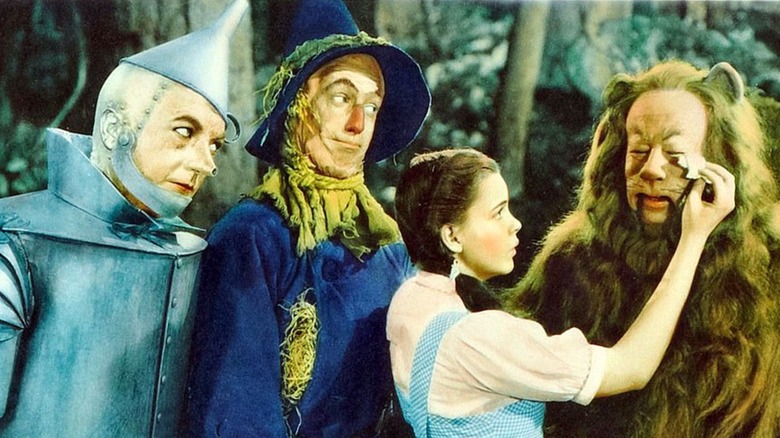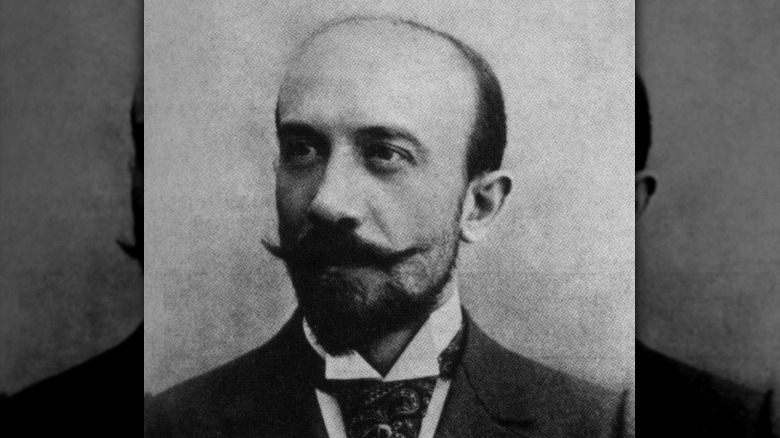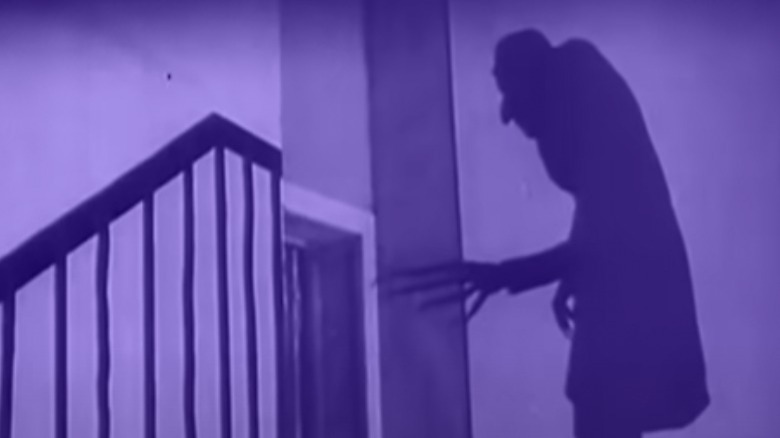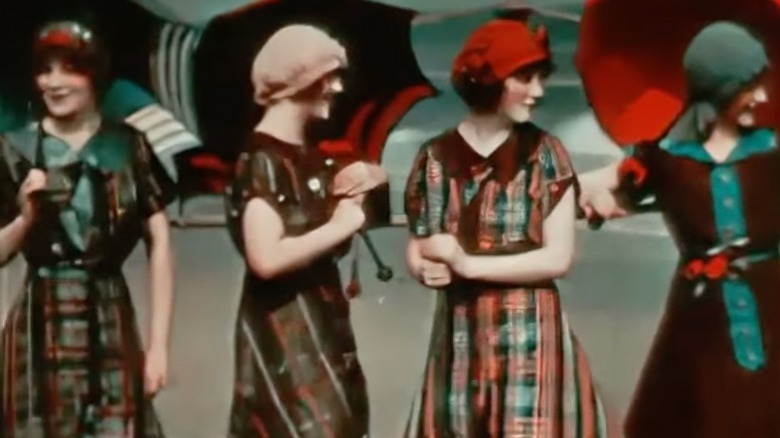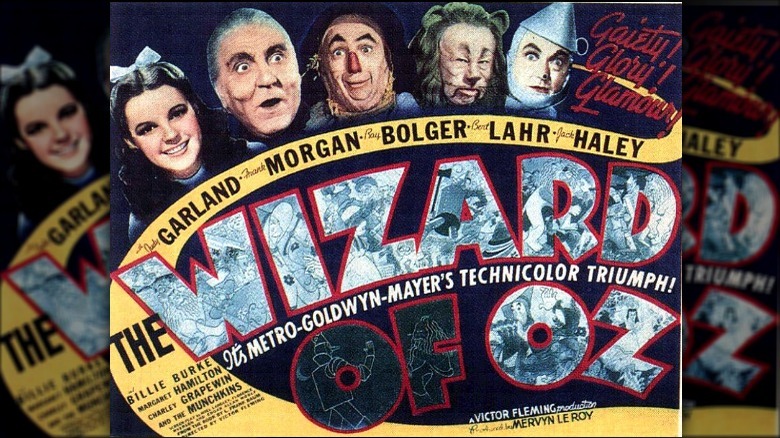The First Color Movie Isn't Actually The Wizard Of Oz After All
"The Wizard of Oz" is a film that still shatters people's minds more than 80 years after its release, and not just when they sync it up to Pink Floyd's "The Dark Side of the Moon." It was a technological marvel for its time with then-cutting edge special effects and stellar performances from the entire cast, but still wasn't much of a commercial or critical success when it was released, per Britannica. One of the aspects the film is also best remembered for is its use of lush, vibrant color, something that was virtually unheard of at the time.
Of course, "virtually" doesn't mean "completely," and this has led to the misconception that the 1939 film was the first to introduce the color film to the silver screen. According to the Nashville Film Institute, "The Wizard of Oz" was preempted by 30 years, though the technology was difficult to wrangle and took a long time to perfect.
Color had been used since the dawn of film
Long before processes that allowed for natural color to be captured on film, filmmakers were trying to find ways to add splashes of color to their work. Film pioneer George Méliès employed a firm that utilized the efforts of more than 200 women to add color to his movies. This was one of the earliest roles in the film industry that women could get, per Women Film Pioneers Project. Some of these colorists had started their careers working in different industries, providing color for lantern-slides and postcards.
It was a painstaking process — each individual frame of a film needed to be colored by hand. Each of the workers was only responsible for one color and the firm used an assembly-line process to get work done as efficiently as possible. It was still a very expensive process. In the early 1900s, the Pathé Company introduced a new system of using stencils to help colorists. Once a stencil was made for a frame, it allowed for multiple prints of a film to be colored quickly.
Mass producing color with tinting
Since the movies were still shot on black-and-white film stock, it allowed for dashes of color to be added to the finish product. It was an expensive and laborious process, even with the aid of stencils. In the 1910s, a new process emerged that allowed more color to be applied quickly, but at the cost of only being able to apply it in certain areas. According to Britannica, the new process was called tinting and it involved — you guessed it — tinting the light areas of film. This was done through one of two methods. According to Britannica, one technique was by dipping the film in dye, while the other method involved using film base that was already colored,
This only allowed for one color to be used, and so resulted in monochrome films. For this reason the coloring was usually used to elicit a specific mood, or to indicate a time of day, as can be seen (above) in some nighttime scenes in the 1922 silent film "Nosferatu" (via Polygon).
Shooting in natural color
While all of these processes allowed for artificial color to be added to film after it had been printed, in 1908, a short film became the first to be shot in natural color. George Albert Smith, a filmmaker from Brighton on the southern coast of England, released an eight-minute short film called "A Visit To The Seaside" (via ACMI). The film captured color using a process called Kinemacolor, which used red and green filters in front of both the camera and projector that alternated and showed color around subjects that were moving. According to Studio Binder, the first non-documentary feature length film shot in color is "The World, the Flesh and the Devil" from 1914. This film also used Kinemacolor but unfortunately, it is now considered a lost film.
Kinemacolor soon gave way to a new process that became much more well-known and widely accepted: Technicolor. While Kinemacolor was a major advancement, its use of only red and green limited the color spectrum it could achieve. Technicolor developed ways of splitting the beam of light that entered the camera into three parts, using an optical cube. According to Britannica, this allowed the camera to capture three beams: one for reds, blues, and greens. Each color was on its own strip of film, which was then exposed, and dipped in the appropriate dyes. All three were then combined, which produced a full-color image.
Technicolor in the 1930s
Work on the Technicolor process started in the 1910s, but it wasn't until 1932 that the company that developed the trade-marked process (which was also called Technicolor) figured out a way to produce films that didn't require theaters to be outfitted with specialized equipment (via Studio Binder). The first film to be released using Technicolor's fourth version of the process was debuted in Walt Disney's Silly Symphony cartoon "Flowers and Trees." Prior to the short's release, Disney signed a two-year deal with Technicolor that gave his studio exclusivity to the process when used for animated shorts. It was still an expensive procedure, given the films needed to be shot on Technicolor's patented cameras.
By 1939, other big-budget films had been released using Technicolor, including Walt Disney's "Snow White" in 1937 and "The Adventures of Robin Hood" in 1938. In 1939, "Gone with the Wind" also used the technology, but "The Wizard of Oz" — which was released the same year — had a breakthrough of its own.
The Wizard of Oz's use of color
By now, it should be abundantly clear that "The Wizard of Oz" was not the first color film ever produced; rather, it was the first to use color as a storytelling device. Sure, older films used the process to let the viewer know if a scene was supposed to be taking place at night, but "The Wizard of Oz" directors Victor Fleming and King Vidor used sepia tones for scenes at the beginning and end of the film that were supposed to take place in Kansas. However, the film makes a transition to bright, vibrant colors upon Dorothy's arrival in the land of Oz (via Nashville Film Institute).
Some decision were made based on the best ways to use the Technicolor technology. For instance, the ruby slippers, one of the most iconic costume pieces in film history, were originally silver in the novel, but it was determined that the deep red color would look better on screen. They were right. However, Technicolor added another element of discomfort to the notoriously dangerous production: The powerful stage lights required to best capture Technicolor images sometimes made the temperature inside the soundstage as high as 100 degrees Fahrenheit.
